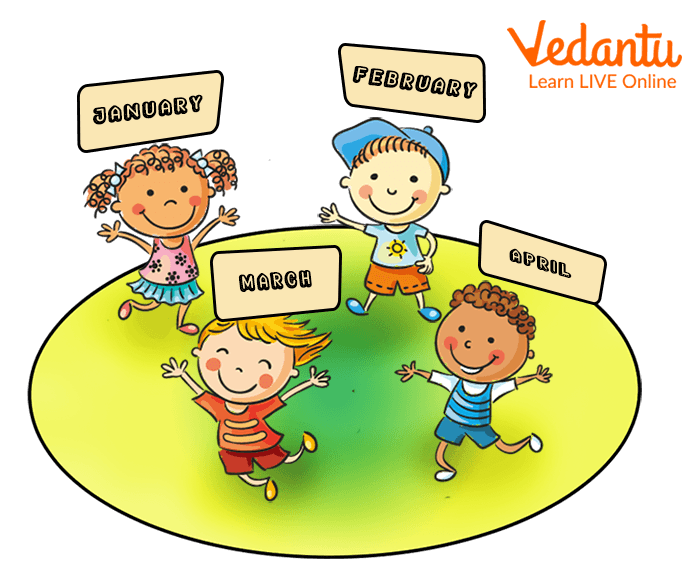




Interactive Months of the Year Exercises to Boost Memory & Master Time
There are 12 months in a year. The sense of months and the names of months are important for kids to learn as it would help them in their schools. Apart from the obvious curriculum benefit, the names of moths can help kids to develop a sense of time that can lead them to develop a healthy habit of planning and time management. Learning the names of months can also help kids memorise their birthdays and other important events.
Parents and teachers can teach months of the year using a variety of songs, games, and basic memorization techniques. As the year progresses and the months become more prominent, kids will develop a greater understanding of how they function and how everything fits together. The article is focused on providing some months of the year activity that can help in memorising the names of months for kids.

Illustrating the names of the month
Activity to Teach Months of the Year
As kids are promoted to pre-school, they must learn the names of months to develop an understanding of time. Mentioned below are some of the activities that can be planned to teach the kids the names of months.
Using a Calendar
Teachers and parents can teach their kids the names of the month with the help of a calendar. Even if the kids are not very proficient at reading, teachers can use a bright and colourful calendar. Go through the different months of the year and prioritise asking questions like, when is Christmas? Or, when is diwali? Associating months with specific events can help kids to memorise the word better. This can also be done with birthdays as they will remember their birthday month and the month followed and proceed by their birthday.
Use Seasons to Associate Months
Kids tend to develop a sense of climate at an early age, so you can engage the kids by asking what is their favourite weather, or whether they like summer holidays and winter vacations. Associating the months with the weather can help kids to memorise the months in sequence. Parents and teachers can also discuss the four seasons and how they occur in the months each year while teaching the names of months.
Playing Games
Games like putting the months in order and touching the walls can be played to teach the names of months in a fun way. In the ‘put the months in order’ game, the students can play in pairs and arrange the names of the months written in cards in a sequential manner.

Illustrating kids playing games
Singing Songs
Parents and teachers can recite the name of months in a rhythmic manner to create interest in children in learning the names of the month. Reciting songs with names of months is a fun activity and it also develops a sense of harmony among kids. Rhymes are an enjoyable approach to emphasise teachings, while also aiding memorization because they repeat the phrases.

Illustrating Kids singing the names of months
In conclusion of the article, we hope to have helped to provide some insights in creating months of the year activity for kids. One of the keys to motivating kids to learn the names of months is to maintain the fun in the activity. Parents who are trying to teach names of months must participate in such games.
FAQs on Months of the Year Activity: Fun Ways for Kids to Learn All 12 Months
1. What is a simple activity to introduce the 12 months of the year to a young child?
A great starting activity is creating a 'Birthday Train'. Draw 12 train carriages, one for each month. Write the name of the month on each carriage and decorate it. Then, help your child place pictures of family and friends in the carriage corresponding to their birth month. This makes learning personal and fun.
2. How can games help kids learn the sequence of the months?
Games make learning active and memorable. For example, in the 'Month Hopscotch' game, you can write the months in order on the floor with chalk. The child then has to hop from January to December in the correct sequence. Another fun game is a 'Month Scramble', where you write each month on a separate card, mix them up, and have the child arrange them in the right order.
3. What is the knuckle method to remember how many days are in each month?
The knuckle method is a clever trick to remember which months have 31 days. Here's how it works:
- Make a fist. Each knuckle (the high bump) represents a month with 31 days.
- The space between the knuckles represents a month with 30 days (or 28/29 for February).
- Start with your first knuckle as January (31 days), the space next to it is February, the next knuckle is March (31), and so on.
4. Why is associating months with festivals or seasons a good teaching method?
This method connects an abstract concept (the name of a month) to a concrete, memorable experience. For a child, remembering 'December' is easier when they associate it with Christmas or cold weather. Similarly, linking 'October' with Diwali or 'April' with the start of a new school session creates strong mental hooks, making it much easier to recall the month's name and its place in the year.
5. Besides games, what are some other creative ways to teach the months of the year?
You can get very creative! Try these ideas:
- Monthly Art Wall: Dedicate a part of a wall to the current month. Have your child draw or find pictures related to that month's weather, festivals, or activities, like umbrellas for July or kites for August.
- Sing-along Songs: Find or create a simple song that lists all twelve months. Music is a powerful tool for memorisation.
- Story Time: Read books where the story progresses through the different months of the year.
6. How can I help a child who struggles to remember the order of the months correctly?
Repetition and visual aids are key. Create a large, colourful yearly calendar and hang it in their room. Go over it with them every day. Focus on small chunks first, like mastering the first three months (January, February, March) before moving on. Also, frequently ask questions like, 'What month comes after March?' to reinforce the sequence in a practical way.
7. At what age should a child typically be able to name all 12 months in order?
While children are often introduced to the months in preschool (around ages 4-5), most are expected to recite them in order by the time they are in Grade 1 or 2 (ages 6-7). However, every child learns at their own pace. The focus should be on consistent and fun exposure rather than strict timelines.









